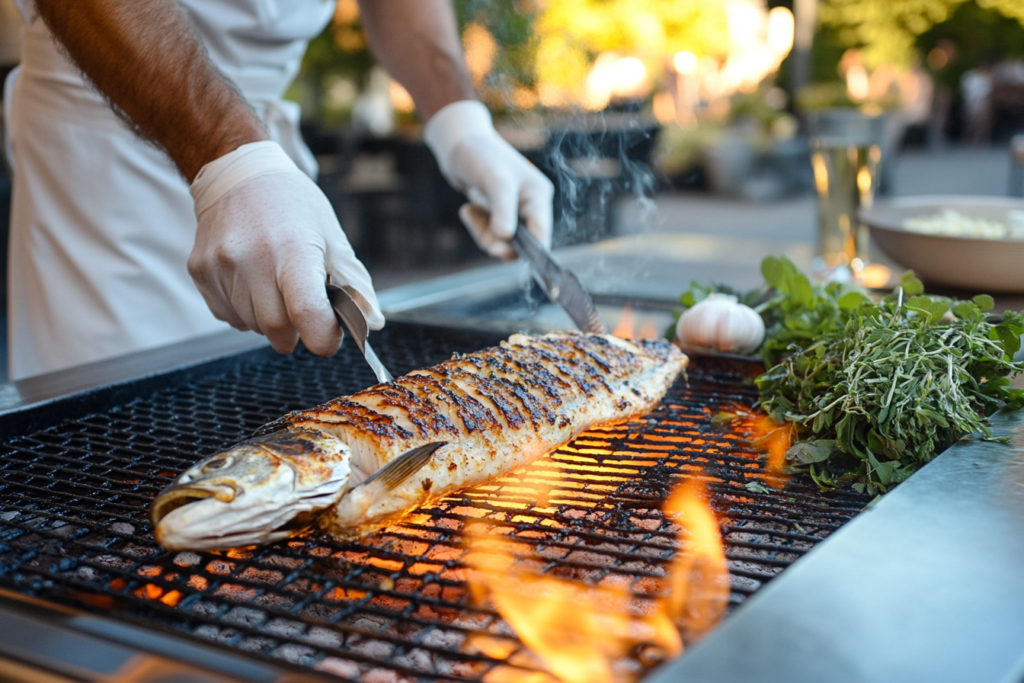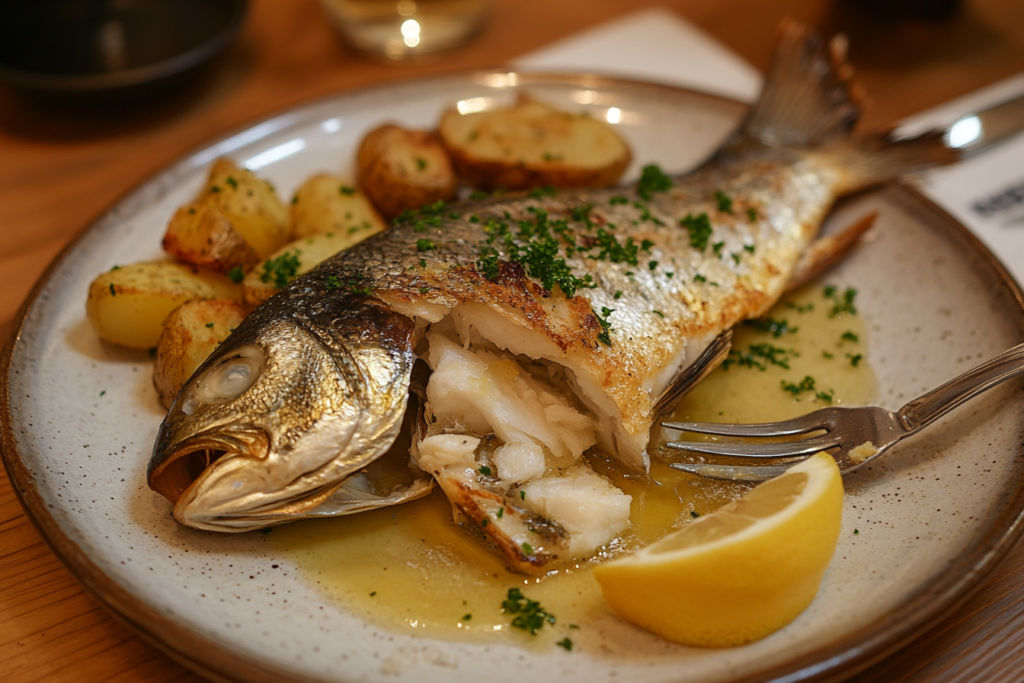Table of contents
- Introduction to Prepare Branzino recipes
- Selecting the Perfect Branzino
- Prepare Branzino for Cooking
- Popular Branzino Cooking Techniques
- Ingredients for Cooking Branzino
- Step-by-Step Recipe: Grilled Branzino
- Step-by-Step Recipe: Baked Branzino Preparation
- Serving and Eating Branzino
- Health Benefits of Eating Branzino
- Common Mistakes to Avoid
- Frequently Asked Questions About Branzino
- Final Thoughts on Cooking and Eating Branzino
Introduction to Prepare Branzino recipes
Branzino, a Mediterranean sea bass, is a versatile and delicious fish, but Bow Do you Cook and Eat Branzino to maximize its delicate flavor? Whether you’re exploring new seafood options or refining your cooking skills, this guide offers everything you need for perfect branzino preparation. From cleaning and seasoning to mastering branzino recipes, you’ll learn all the essential tips.
How Do You Cook and Eat Branzino, and what is it?
Branzino, also known as European sea bass, is a popular saltwater fish native to the Mediterranean Sea and parts of the Atlantic Ocean. For those wondering how do you cook and eat branzino, it’s prized for its mild, delicate flavor and flaky white flesh, making it a versatile choice for various cuisines.
Nutritional Value of Eating Branzino
Branzino is a healthy, nutrient-rich fish. It is high in protein, omega-3 fatty acids, and essential vitamins like B12 and D. Additionally, it is low in calories and saturated fat, making it a heart-healthy option
Culinary Importance of branzino preparation
In culinary arts, Branzino is celebrated for its adaptability. It is often roasted, grilled, or baked whole to preserve its natural flavors. Its mild taste pairs well with herbs, citrus, and olive oil, making it a favorite in Mediterranean dishes.
Selecting the Perfect Branzino
Knowing how do you cook and eat branzino starts with selecting the right fish. While fresh branzino offers vibrant flavors, frozen options can be a convenient alternative when fresh isn’t available. Both choices work well depending on the recipe and preparation method.
Fresh vs. Frozen for branzino preparation
Choosing between fresh branzino and frozen depends on your recipe and availability. Fresh fish is ideal for dishes where the natural flavor stands out, but frozen options are convenient and retain quality when stored correctly. Both options work beautifully in a variety of branzino recipes.
Go fresh to Prepare Branzino
Fresh branzino offers unparalleled flavor and texture. If you have access to a reputable fish market, fresh branzino is an excellent choice, especially for dishes where the fish’s natural taste is the star. Fresh fish often retains its firmness and has a clean, mild aroma.
Frozen Branzino
Frozen branzino can be just as good if handled properly. Freezing locks in the fish’s freshness when done promptly after catching. It’s a convenient option for those living far from coastal areas or looking to stock up for later use. Always check the packaging for proper sealing and avoid fish with visible freezer burn or excess ice crystals.
How to Identify Fresh Branzino Recipes
When buying fresh branzino, look for these indicators of quality:
- Eyes: Clear, bright eyes are a good sign of freshness. Avoid fish with cloudy or sunken eyes.
- Skin and Scales: The skin should be shiny, moist, and free of discoloration. Scales should be intact and firmly attached to the body.
- Gills: Fresh branzino has vibrant red or pink gills. Dull or brownish gills are a sign the fish is past its prime.
- Smell: A fresh branzino smells like the ocean—clean and slightly briny. Avoid fish with a sour or overly “fishy” smell.
- Texture: The flesh should be firm and spring back when pressed gently.
Where to Buy Branzino for branzino recipes
To ensure you’re getting the best branzino, consider these purchasing options:
- Local Fish Markets: Look for a trusted fishmonger who sources sustainably and can answer questions about the fish’s origin and freshness.
- Supermarkets: Many large supermarkets now offer fresh branzino in their seafood sections. Opt for stores with high turnover rates to ensure freshness.
- Online Seafood Retailers: Reputable online sellers often provide detailed sourcing information and deliver branzino flash-frozen to maintain quality.
- Farm-to-Table Options: Some suppliers specialize in farmed branzino raised in environmentally conscious conditions, which can be a sustainable and reliable choice.
By carefully selecting your branzino, you set the stage for a memorable meal. Whether fresh or frozen, a high-quality fish will always elevate your dish.
Prepare Branzino for Cooking
Before diving into the question how do you cook and eat branzino, ensure your fish is properly cleaned and prepped. Proper branzino preparation, including gutting, scaling, and deboning, sets the foundation for a flavorful and delicious dish.
Cleaning and Gutting for Better Branzino Recipes
- Rinse Thoroughly: Wash the fish under cold water to remove any surface impurities.
- Make the Cut: Use a sharp knife to cut along the belly from tail to head.
- Remove the Innards: Scoop out the internal organs with a spoon or your fingers. Be careful not to puncture the stomach lining.
- Final Rinse: Rinse the cavity thoroughly to ensure no blood or residue remains.
Scaling Tips for Beginners to Prepare Branzino
- Choose Your Tool: Use a fish scaler or the blunt edge of a knife.
- Scrape Against the Grain: Starting from the tail, scrape toward the head to remove scales.
- Contain the Mess: Perform this step over a sink or a large bowl to catch loose scales.
- Double-Check: Run your fingers over the skin to ensure no scales are left.
- Rinse Again: Wash the fish to remove any remaining debris.
Removing Bones to Prepare Branzino
- After Cooking for Ease: Deboning is simpler when the fish is cooked, but it can also be done raw.
- Remove the Spine: Cut along the backbone and gently lift it out.
- Extract Pin Bones: Use tweezers to remove smaller bones from the fillet.
- Check Thoroughly: Feel the flesh to ensure all bones are removed before serving.
Popular Branzino Cooking Techniques
Grilling Branzino to Perfection
Grilling is a top choice for those wondering how do you cook and eat branzino. The smoky flavor adds a unique touch, while a crispy finish elevates the dish. With just a few ingredients and simple steps, you’ll master this classic branzino recipe.
- Preheat the grill to medium-high heat.
- Season the fish with olive oil, salt, pepper, and fresh herbs like thyme or rosemary.
- Grill for 4–5 minutes per side, flipping carefully to maintain the fish’s integrity.

Baking Branzino with Aromatics for Healthy Eating
- Preheat the oven to 375°F (190°C).
- Stuff the cavity with slices of lemon, garlic cloves, and herbs like parsley or dill.
- Bake on a lined sheet for 20–25 minutes or until the flesh flakes easily.
Pan-Frying Branzino for a Crispy Finish
- Heat a skillet with olive oil or butter over medium-high heat.
- Pat the fish dry and season with salt and pepper.
- Cook skin-side down for 3–4 minutes until crispy, then flip and cook for another 2 minutes.
Ingredients for Cooking Branzino
Essential Herbs and Spices
- Herbs: Thyme, rosemary, dill, parsley, and basil.
- Spices: Salt, black pepper, paprika, and garlic powder.
- Optional Additions: Lemon zest, chili flakes, or fennel seeds for extra flavor.
Best Oils and Fats for Cooking Branzino
- Olive Oil: Ideal for grilling, roasting, and drizzling.
- Butter: Adds richness to pan-fried branzino.
- Avocado Oil: A great high-heat alternative for grilling or searing.
Suggested Sides to Pair with Branzino
- Vegetables: Roasted asparagus, sautéed spinach, or a fresh tomato salad.
- Carbs: Lemon risotto, couscous, or crusty bread.
- Sauces: Lemon butter sauce, garlic aioli, or a herb vinaigrette.
Step-by-Step Recipe: Grilled Branzino
Branzino Preparation Steps for Cooking Grilled Branzino
- Clean and gut the fish.
- Season with olive oil, salt, pepper, and minced garlic.
- Stuff the cavity with lemon slices and fresh herbs.
Grilling Instructions
- Preheat the grill to medium-high heat.
- Oil the grates to prevent sticking.
- Place the fish directly on the grill and cook for 4–5 minutes per side.
- Use a wide spatula to carefully flip the fish.
Plating and Presentation Tips
- Serve whole on a platter with additional lemon wedges and a sprinkle of fresh parsley.
- Pair with a light salad or grilled vegetables for a complete meal.
Step-by-Step Recipe: Baked Branzino Preparation
Preparing the Marinade for Baked Branzino
- Combine olive oil, minced garlic, lemon juice, and your choice of herbs in a bowl.
- Rub the marinade generously over the fish, inside and out.
Baking Instructions for Cooking Branzino Perfectly
- Preheat the oven to 375°F (190°C).
- Line a baking sheet with parchment paper.
- Place the fish on the sheet and bake for 20–25 minutes until the flesh flakes easily with a fork.
Garnishing Ideas for Delicious Branzino Recipes
- Garnish with fresh dill, lemon slices, or capers.
- Serve with roasted potatoes or steamed green beans for a balanced plate.
By following these techniques and recipes, you’ll master the art of preparing and cooking branzino. So, how do you cook and eat branzino to impress guests with both flavor and presentation? This guide ensures you’re equipped with everything you need to create a stunning dish.
Serving and Eating Branzino
How to Serve Whole Branzino Recipes
- Presentation: Place the whole branzino on a large platter for an impressive display. Arrange garnishes such as fresh herbs, lemon slices, and colorful vegetables around the fish.
- Preparation for Guests: Use a sharp knife to gently cut along the backbone to expose the fillets. Remove the head and tail if desired for easier serving.
- Serving Portions: Divide the fish into sections, ensuring each guest gets a portion of the tender, flaky flesh. Offer a spoon or small fork to help guests separate the meat from any bones.

Techniques for Eating Branzino and Avoiding Bones
- Inspect Before Eating: Use a fork to gently lift the flesh off the backbone, moving from the head toward the tail.
- Remove Larger Bones: As you eat, remove visible bones and place them on the side of your plate.
- Small Pin Bones: If a small bone is missed, don’t panic—use your fingers to extract it gently or set it aside.
- Serve Deboned Portions: If you prefer a hassle-free experience, pre-debone the fish before serving.
Pairing Eating Branzino with Drinks
- White Wines: Crisp whites like Sauvignon Blanc, Pinot Grigio, or a buttery Chardonnay complement the delicate flavors of branzino.
- Rosé Wines: A dry rosé pairs well, especially if the dish includes Mediterranean herbs or a citrus profile.
- Beer Options: A light lager or wheat beer offers a refreshing contrast to the fish’s richness.
- Non-Alcoholic Choices: Sparkling water with a splash of lemon or a chilled herbal iced tea can enhance the meal’s flavors.
Health Benefits of Eating Branzino
Branzino: A Rich Source of Omega-3 Fatty Acids for Health
Branzino is packed with omega-3 fatty acids, which are essential for brain function, reducing inflammation, and maintaining overall health. These healthy fats support cognitive health and may lower the risk of depression and anxiety.
Low-Calorie Protein Benefits of Eating Branzino
Branzino is a lean source of high-quality protein, making it an excellent choice for those watching their calorie intake. A typical serving is low in fat and calories while providing essential nutrients like selenium, phosphorus, and vitamins B6 and B12.
How Eating Branzino Supports Heart Health
The omega-3 fatty acids in branzino play a vital role in cardiovascular health by reducing triglycerides, lowering blood pressure, and preventing arterial plaque buildup. Regular consumption of branzino may contribute to a healthier heart and reduce the risk of heart disease.
Incorporating branzino into your diet not only provides a delicious dining experience but also offers a wealth of health benefits, making it a wholesome addition to your meals.
Common Mistakes to Avoid
Over cooking Branzino
One of the most common errors when preparing branzino is overcooking, which can lead to dry, rubbery flesh. To avoid this:
- Monitor Cooking Time: Branzino cooks quickly, typically 10 minutes per inch of thickness, regardless of the cooking method.
- Check for Doneness: The fish is ready when the flesh flakes easily with a fork and appears opaque. Avoid leaving it on the heat longer than necessary.
- Use a Thermometer: For precision, aim for an internal temperature of 135–140°F (57–60°C).
Using the Wrong Spices When Preparing Branzino
Branzino’s delicate flavor can be easily overwhelmed by strong or inappropriate spices. To enhance rather than mask the taste:
- Stick to Light Flavors: Use herbs like thyme, dill, or parsley and spices like black pepper, paprika, or garlic powder.
- Avoid Overpowering Branzino Recipes Ingredients: Strong flavors like cumin or overly sweet glazes can dominate the fish’s natural taste.
- Balance is Key: Pair subtle seasonings with a touch of citrus or olive oil for a harmonious flavor profile.
Forgetting to Remove All Bones
Nothing disrupts a meal like encountering unexpected bones. To prevent this:
- Double-Check Before Serving: Use fish tweezers to remove pin bones from the fillets.
- Educate Yourself on the Fish’s Structure: Understand the bone placement in branzino to ensure thorough removal.
- Serve Deboned Portions for Guests: If you’re hosting, consider removing the bones entirely before serving to provide a hassle-free dining experience.
Avoiding these common mistakes will elevate your branzino dishes, ensuring they are perfectly cooked, well-seasoned, and enjoyable to eat.
Related Recipes You’ll Love
When exploring ways to prepare branzino, consider checking out our detailed guide on the Easy Cooking Guide for Branzino Recipes for step-by-step instructions. For those curious about the origins and culinary uses of this fish, our article What Kind of Fish is Branzino? provides in-depth insights. Additionally, if you’re debating whether to include the skin in your dishes, read Eating Branzino Skin: Benefits and Risks to make an informed decision. These resources can enhance your knowledge and help you master the art of cooking branzino.
Frequently Asked Questions About Branzino
How to Properly Eat Branzino?
To enjoy branzino, start by gently separating the flesh from the bones using a fork. Work from the head toward the tail to avoid encountering small bones. If served whole, remove the backbone and larger bones before eating. If you’re unsure about deboning, ask your server or chef to assist when dining out.
Are You Supposed to Eat the Skin on Branzino?
Yes, you can eat the skin of branzino if it’s properly prepared. The skin becomes crispy and flavorful when grilled, baked, or pan-fried. However, if the skin is not to your liking, it’s easy to peel away after cooking. Always ensure the fish is cleaned and scaled thoroughly for the best experience.
Should I Wash Branzino Before Cooking?
Yes, washing branzino is a key step in preparation. Rinse the fish under cold running water to remove any residual scales or impurities. If the fish is not already gutted, wash the cavity thoroughly to eliminate any blood or remaining internal matter. Pat the fish dry with a paper towel before cooking to ensure better seasoning adhesion and crispier skin.
Is Branzino a Good Fish to Eat?
Branzino is an excellent fish to eat! Its mild, sweet flavor and tender texture make it versatile for a variety of Branzino recipes. It’s also a healthy option, being rich in omega-3 fatty acids, low in calories, and a great source of lean protein. Whether grilled, baked, or fried, branzino is a delicious and nutritious addition to any meal.
Final Thoughts on Cooking and Eating Branzino
Summary of Branzino Preparation, Cooking Branzino Techniques and branzino Recipes
How do you cook and eat branzino? Cooking and preparing branzino is simpler than it may seem, and mastering basic techniques can elevate your culinary skills. Start by properly cleaning, scaling, and deboning the fish to ensure a smooth cooking process. Popular methods like grilling, baking, and pan-frying bring out branzino’s natural flavors, while careful seasoning with fresh herbs and spices enhances its mild, delicate taste.
Encouragement to Experiment with Flavors
While traditional Mediterranean seasonings like olive oil, garlic, and lemon are classic choices, don’t shy away from experimenting with new flavor profiles. Try Asian-inspired marinades with soy sauce and ginger, or bold, spicy rubs for a unique twist. Branzino’s versatility makes it an excellent canvas for your culinary creativity.
Embracing Branzino in Your Diet
Incorporating branzino into your diet is not only a treat for your taste buds but also a boost for your health. Its high omega-3 content, lean protein, and low calorie count make it a smart choice for balanced eating. For those wondering how do you cook and eat branzino, it’s versatile enough for hosting a dinner party or preparing a quick family meal, offering a delightful way to enjoy nutritious and flavorful seafood.
With these tips and techniques, you’re ready to explore the joys of cooking and eating branzino. Bon appétit!

